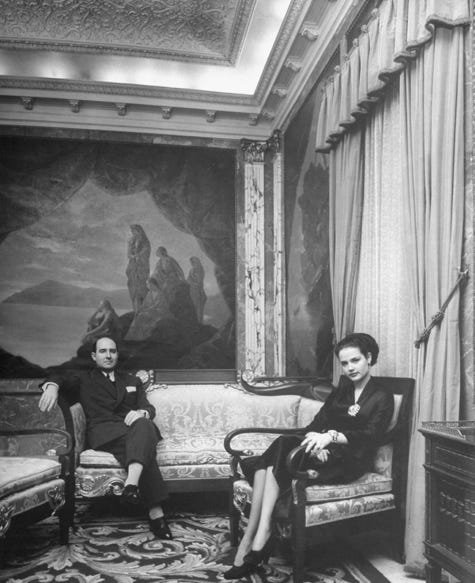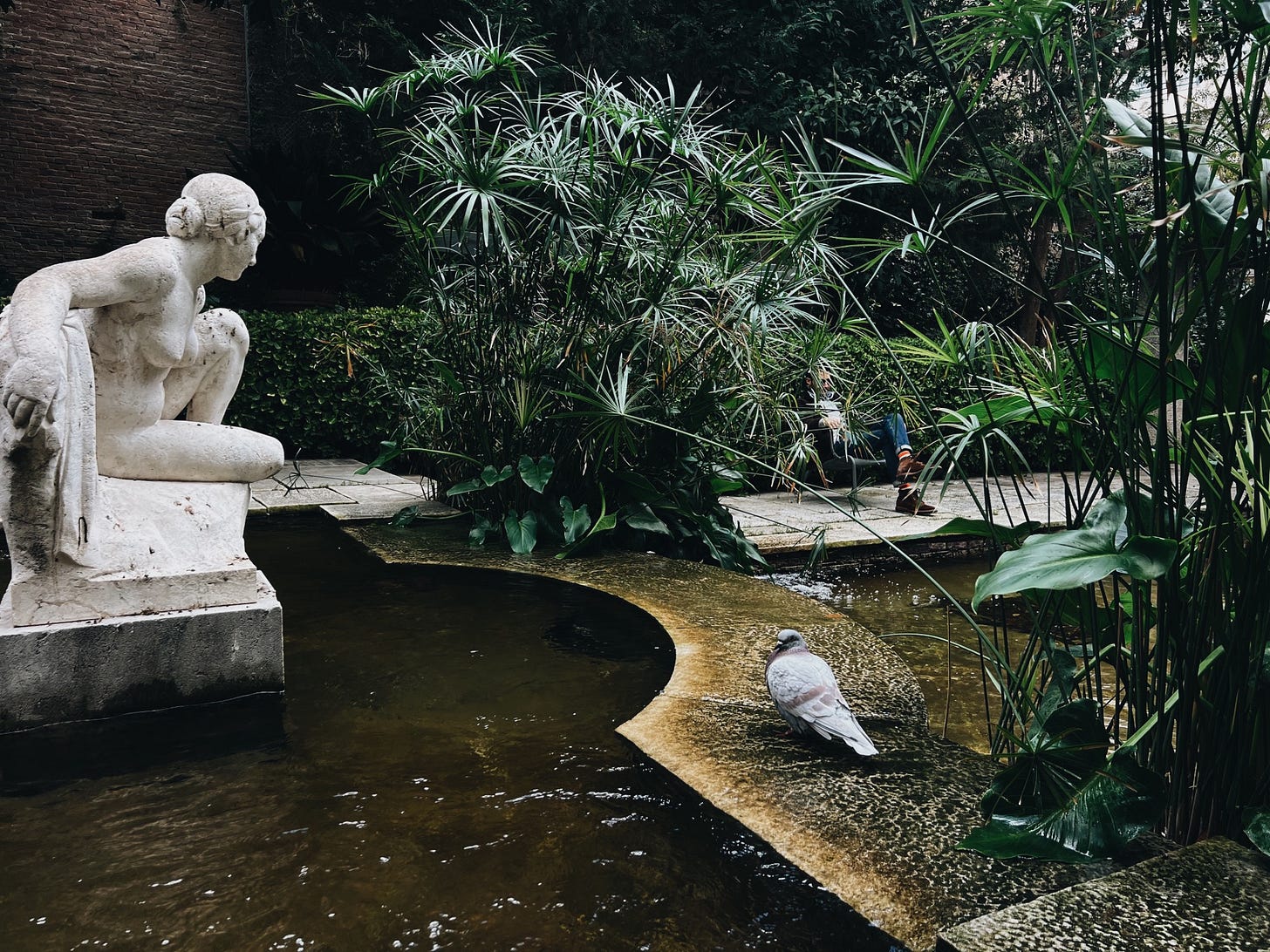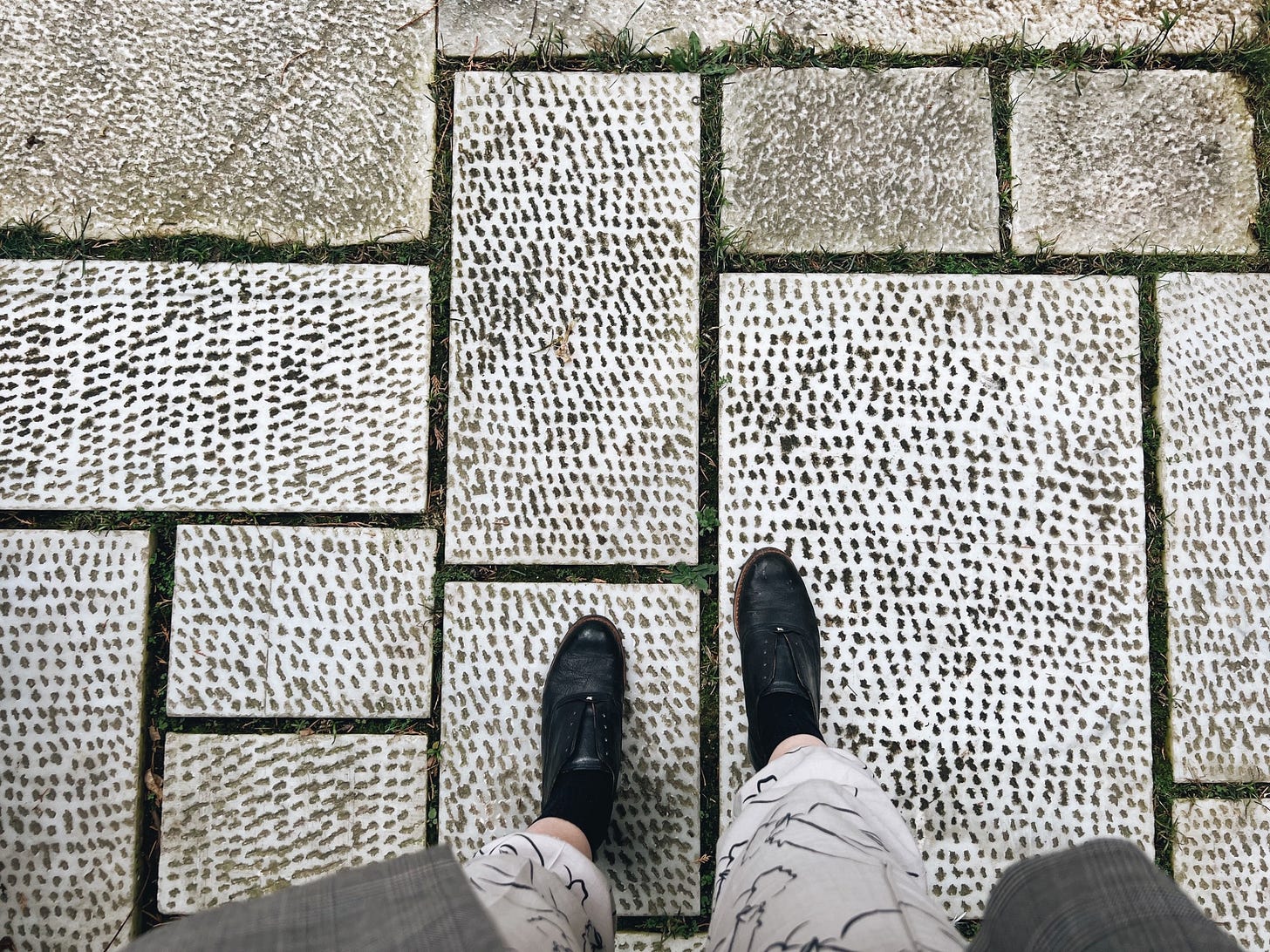🇪🇸 another spanish garden, another tale of scandal 🇪🇸
do any gardens come without bad behavior?
If you missed last week’s newsletter, I recapped my visit to de Cap Roig garden on the mediterranean coast in Palafrugell, two hours north of Barcelona. More importantly, I discovered the secret and scandalous history of the woman who created it — which is hidden when you visit or search casually around online for its origin.
Today I sat down to recap three smaller gardens in the heart of Barcelona, but alas, I have found more crime, more sex, and more scandal. So today, I will only take you through one: The history of Jardins Muñoz Ramonet.
Jardins Muñoz Ramonet
This garden is a small one, dropped right into the densest part of the city. It was created by Julio Muñoz Ramonet, shown here with his wife Carmen Villalonga at their wedding in 1946.
The public garden’s website would paint you a rosy picture of Julio and his brother creating and purchasing dozens of companies, including one of the original Ritz hotels — and marrying Carmen, the daughter of the owner of the Central Bank. They went on to have four daughters of their own and moved into a stunning mansion in the heart of Barcelona with private gardens designed in 1916 by the French landscape architect, Jean Claude Nicolás Forestier.
While I am reminded that most great gardens are the children of great wealth, I think always of Balzac’s sentiment: “Behind every great fortune is an equally great crime.”
And now, I dig.
Firstly, Julio was a paranoid and impulsive man. He refused to let anyone shave him, for fear of his throat being slit. When he flew, which was often, he bought every single seat on the flight to fly alone. He once got so angry that his favorite restaurant couldn’t seat him that he got out his checkbook to attempt to purchase the business on the spot.
A large percentage of Julio’s wealth came from the black market for cotton and his shady favors for the Franco regime. He smuggled and laundered through his factories — including Nazi looted artwork. In the underworld he was known as El Rey del Estraperlo which translates to The King of Blackmail. He was the richest man in Spain, thanks to his lucky marriage and collection of tax havens around the world, but the beginning of the end came when he divorced Carmen. He was set to inherit the Central Bank, but Carmen’s mother withdrew her support, and Julio’s other businesses began facing bankruptcy.
When he died, he wrote all four daughters out of his will to everyone’s shock — and left his property to the city of Barcelona.
It’s important to note that Julio died in Switzerland after fleeing a major insurance fraud investigation. (He burned down his factories and used the payouts from an insurance company that HE OWNED to get into real estate. All six senior officials were arrested but he was…already in Switzerland, where he owned multiple banks.) One of Julio’s lawyers holds that Julio bitterly revoked his daughters’ inheritances for “not coming to Switzerland to care for him.”
But, perhaps in revenge, all four daughters successfully pulled off one of the largest art heists in history. Before the home was handed over to Barcelona, around 800 paintings went missing (Rembrandt! El Greco! Goya!) — and the city spent 20 years suing the daughters for over 853 paintings.
Perhaps Julio’s daughters were upset that part of their fortunes had also gone to other women around the world. Or perhaps the saw through his charade of leaving his wealth to the city with the last-wish desire to be seen as a benefactor of the arts in society — when really he was a philandering criminal who left them behind. Or maybe they just really wanted that art.
I’d be remiss to mention Julio’s most well-known and long-lasting affair: Carmen Broto. A high-end prostitute, she was murdered at age 25 in another garden (that now I must visit) by Jesús Navarro Manau and his father. She had acquired such a collection of wealth and fine jewelry in such a short time from her many notable lovers that Jesús schemed to frame Broto for a theft — and take Broto’s assets and another’s.
One of the most frustrating realities when studying these gardens is that women (particularly wives) are often invisible. There is NOTHING about Carmen. Anywhere. If Julio bought the Muntaner 288 mansion in 1945, married her in 1946, and then hired Joan Mirambell i Ferran in 1958 to renovate the gardens, I can only assume he did so to placate Carmen with home improvements while she was raising their 4 daughters and he was galavanting with multiple women and businesses. Most accounts claim he was rarely in town, leaving her alone. Lourdes, a secret-since-childhood girlfriend of Julio’s insists he was resentful of never getting a son to guarantee his inheritance of Central Bank, and even regretted the strategic marriage as soon as it happened.
Was this Carmen’s garden? What role did she play in its evolution? Did she want the flower beds replaced with a swimming pool for her daughters? Was she sad to leave it in their divorce in 1978, or was she relieved for her own space to finally wield her artistic expression? Did she only finally have the freedom to leave because a year or two earlier her father passed, leaving her and her children millions? Did she know her life would be like this when she married a man like her father? Was a palace and a garden the promise made? She was one of 8 children; an overlooked girl who became an overlooked woman. Where did she find herself? Did she welcome other men or women into these gardens? Did she resent them?

We will never know — but Julio Muñoz Ramonet died in 1991 and the gardens were only opened to the public in 2016. In fact, the property was actively being renovated while we visited, as the city is eager to add it to its suite of hard earned historical landmarks.
AND NOW, THE ACTUAL GARDENS
Until next week, adéu and bon nadal!!
Lauren
























I'm loving this whole dark side of the gardens this ended up turning into! Would definitely make a great podcast as well lol. I'll be in Barcelona in May, I'll be keeping these gardens in mind.
Fascinating! Thank you for sharing all of this.